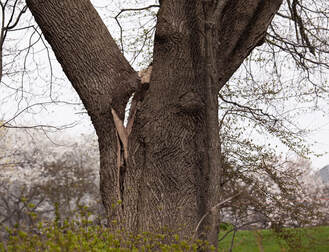 A tree with a dangerously cracked branch A tree with a dangerously cracked branch It isn't easy to recognize dangerous trees. That's because trees have identifiable enemies such as disease and drought. Keep reading to know which red flags to take notice of among the trees in your landscape. Spotting Dangerous Trees: A Game of Hide and Seek To start your examination of a tree, go to the bottom. If ground cover plants are covering the bottom of the trunk, pull them back. The presence of mushrooms could denote a severe issue. Move on to inspecting the perimeter under its canopy. Look for roots coming up from the dirt. Noticeable roots are not challenging in and of themselves. However, if there are indications to suggest that the tree is stressed, then jutting roots could mean that the tree is on the brink of falling over. Lightning If you come across a tree that's missing pieces of bark on its trunk, lightning probably hit it. Made up of water, trees are good electricity conductors. When lightning hits the canopy, it goes to the root system, boiling sap and creating steam. If there's damage to only one side, the tree may completely recover. But if the bark is missing on many sides, the tree is possibly not going to survive. Branch Inspection Since dead branches are the first to drop, it's wise to get rid of them from trees situated close to the house. On deciduous trees, dead limbs either have brown leaves or no leaves. If inspecting evergreen trees, look for no bark and brown needles. When it comes to pruning, hire a tree expert. Two-Trunk Trees When trees have two or more trunks, inspect the point where they unite. U-shaped connections between trunks are typically not an issue. However, a tight "V" shape signifies a weak spot. If you're anxious about a particular tree, you can have from splitting in two. For this project, you need to hire a tree professional. If you are unsure about the health of your trees, you should hire a certified arborist. Besides possessing the much-needed knowledge, training, and experience, arborists have specialized equipment they can use to make high-level analyses. Call Tree Service York PA and speak with one of our skill arborists. |
© Tree Service York PA 2016-2020
Leaders Heights | Jacobus | Emigsville | Mount Wolf | Manchester| Marietta | Bainbridge | Wrightsville | Dallastown |Windsor | East Prospect |York Haven | Red Lion | Dover | Loganville | Seven Valleys
Tree Service York PA
2536 Eastern Blvd #102
York, PA 17402
(717) 216-4888
2536 Eastern Blvd #102
York, PA 17402
(717) 216-4888
